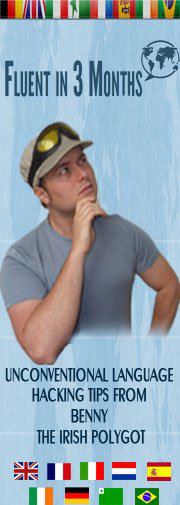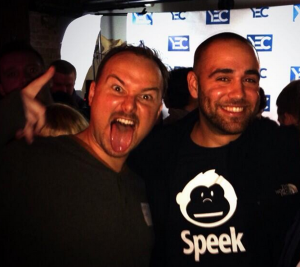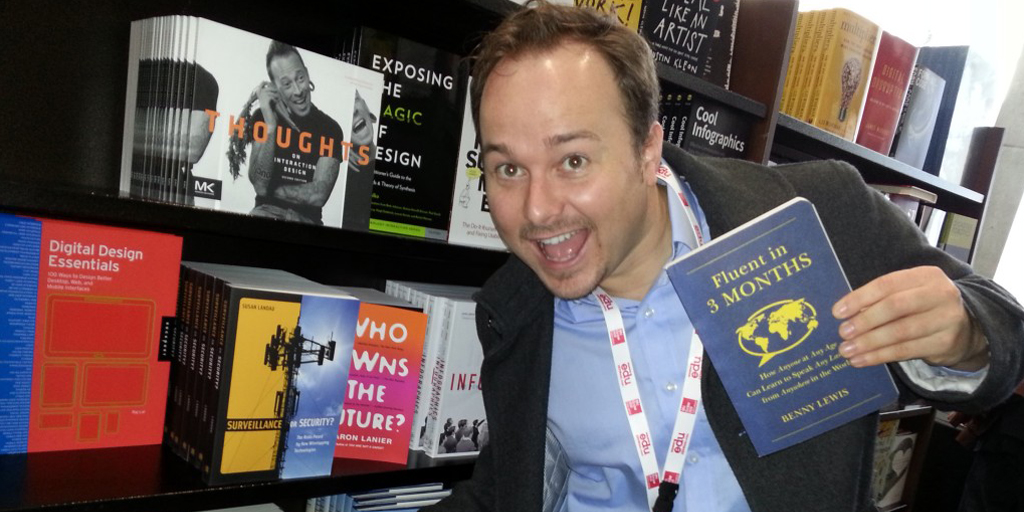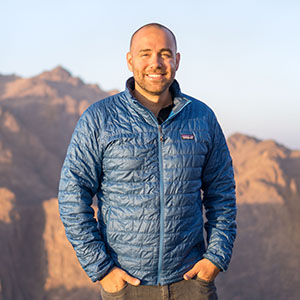The Language Learning Strategy to be Fluent in 3 Months.
I recently hosted a digital fireside chat with foreign language learning expert, Benny Lewis (aka “The Irish Polyglot”), to discuss his language learning tips for how to quickly learn any foreign language. Benny is fluent in over 10 languages, is the creator of the world’s most popular language-learning blog, FluentIn3Months.com, and was last year’s National Geographic Traveler of the Year. Benny also recently turned his experiences into a best-selling book – Fluent in 3 Months: How Anyone at Any Age Can Learn to Speak Any Language from Anywhere in the World – and graciously took some time away from a busy book tour to chat with the Speek community and me about learning, languages, travel, and life. Here are the highlights (with some slight edits):
Getting started with language learning

I did poorly with languages in school. I could only speak English up to the age of 21. Then, I moved to Spain, lived there for 6 months and I did not actually pick up any Spanish. I spent all that time speaking English with everyone. I simply assumed that I was bad at learning languages, but everything changed with a little bit of experimentation. I tried everything, but a lot of those courses failed. I eventually realized that the one thing I wasn’t doing in my attempts to learn Spanish was speaking Spanish. That’s when it all changed. I started to actually use the language rather than make it about learning the language.
You have to have a particular approach as an absolute beginner. You have to start the language with the focus being on communicating. Don’t worry about communicating perfectly: Avoid a grammar book as a beginner and pick up a phrase book or learn a few basic words instead. Learn them quickly and speak from day one. Use the language even if it’s via the internet. With that, you will get practice, even if you speak like Tarzan. You don’t have to speak perfect sentences, you just have to say something. That’s my focus at the start, not to speak perfectly, just to speak.
Approaching a new foreign language
If I was starting a new language from scratch, I would get the phrase book learn a few basic necessities: hello, please, thank you and so on. On the same day, I’d start talking to native speakers on Skype (or Speek) through sites like italki.com. It’s just a couple bucks an hour and you get a private one-on-one with a real human being. If you’re on a budget, you can use sites that offer free exchanges. That’s what the core of my learning each and every day is all about, a spoken session with a real person.
On the first session, I won’t be able to say very much, so I kind of cheat a little bit. I just learn one phrase: “could you write that out please?” You don’t even have to have the phrase down perfectly, you could get it on google translate. Someone will say something to you in that language on Skype and you can just copy that and paste it into the translator, it would tell you what it is in English, and you could translate back what you want to say in English and say that back. This way, you use an online translator as a crutch. Now what you’re going to say is going to be very broken, it’s going to sound very weird, automatic translators are not a good solution to language learning, but they can help ease you into it. That way it doesn’t matter how little you know, you can still use the translator get into your first conversation. When you have that conversation, you’re going to see what you need to say more of.
 I like to be as spontaneous as possible in these conversation, but also realize that most first conversations you have with people can be predictable. I’m not likely to talk about the price of tea in China going in my first conversation with someone. That’s just not something that’s going to come up. I’m more likely to say who I am, why am I learning the language, where I am from, what do I do for a living, and how I found this website. Then I will ask this person how they are doing, what they do for a living, and so on. Since these introductory conversations are what I’m more likely to talk about when I meet someone, these are the kind of phrases I focus on learning first. They may not be in my phrase book, but I might try to find out how to say “I’m Irish”, “I’m a blogger”, or “I’m an author”, and look it up and run with that.
I like to be as spontaneous as possible in these conversation, but also realize that most first conversations you have with people can be predictable. I’m not likely to talk about the price of tea in China going in my first conversation with someone. That’s just not something that’s going to come up. I’m more likely to say who I am, why am I learning the language, where I am from, what do I do for a living, and how I found this website. Then I will ask this person how they are doing, what they do for a living, and so on. Since these introductory conversations are what I’m more likely to talk about when I meet someone, these are the kind of phrases I focus on learning first. They may not be in my phrase book, but I might try to find out how to say “I’m Irish”, “I’m a blogger”, or “I’m an author”, and look it up and run with that.
You can write out a 30 second long introduction to yourself, where you’re from, what you do, what you like and have that translated to the target language and learn that all and that is essentially your first 30 seconds of every conversation that you’re going to have with everybody. With that in mind you already have momentum because as other people tell me they don’t know what to say when they meet somebody. I tell them, learn what you’re likely to say and there you go, you’ve got your momentum.
I try to be spontaneous and I use a crutch to help me get along as I start talking to somebody, but I still have particular things I can be confident about saying.
Finding time for language learning
For a businessperson or somebody with a lot of responsibilities already, you can absolutely make the time to make a major advancement in your language project. I myself haven’t always had this lifestyle: I learned Italian, my second language, while working a 63-hour-a-week job (which was barely legal but I did it anyway). I still managed to learn Italian and the time constraint was a problem, but I found more ways to make the time.
Up until then, for instance, I watched way too much television. Whatever little free time I had, I would sit down and watch some silly show, but I decided that for the next couple of months, I was intensely learning Italian, and would give up watching television to make time. There’s all the little moments of time that people don’t realize are getting lost, like if you’re standing in line somewhere or waiting for an elevator, you could be taking out your smart phone and going through flash cards. Or you could be listening to an audio course while driving your car. So this is why, when people say “how much time should I invest?”, it should be as much time as possible. If you want to be fluent in a language quickly, you need to do it intensively. You can’t say, “oh I’ll make the time to find like an hour a week” or something: it doesn’t work that way. You need to keep your momentum up and you need to be constantly learning, so I would be doing it at least one hour a day, finding that one hour somehow to dedicate just to your language, ideally two hours or more.
If someone really looks at their day and sees where the time goes, do I go out with my friends to a barbeque? Go down to the bar? You decide, “well, for the next 3 months I’m going to make a sacrifice: I’m not going to be social in English, but maybe I’m going to be much more social in Spanish.” And when you make that decision for the next three months or six months or whatever period you decide, it will make a major difference.
If someone is working a full-time job, I would generally aim for basic conversation level in 3 months. That’s something that’s very realistic. If you’re practicing it consistently, you can reach a level where you can have most conversations with a native speaker, if they’re patient and speak slowly. You can absolutely reach that within three months if you’re doing that for one or two hours a day.
Language learning as an adult
People think you have to learn it as a child, and I’ve tried to see if there’s some research to back this up, but there is no consensus in linguistics that you become a worse language learner with age. I actually did find research showing that adult language learners are better language learners than children under the right circumstance. You just have to make sure you’re learning the right way. The problem is that most adults don’t learn a language. This isn’t necessarily because of the fact that they can’t, it’s because of how they do it. Their approach is wrong, they study grammar books, and they go to class rooms filled with thousands of people where they don’t actually use the language. A child will play in the language, talk in the language, and they’ll generally use it. That’s what we have to do too.
Making language learning manageable
I’d usually spend maybe half the time speaking, you could have a half an hour or one hour Skype session at the end of your day, or at the beginning. At the end is generally good because you use the other hour or hour and a half to work up to that. So at the end of your spoken session, you know what your biggest problems are: you might say, “oh man, I don’t know any action words. I don’t know any verbs, like to do, to make, to go, to eat.” You would write that down and then just focus on that the next day. The key is that you’re not just taking a generic course and following it through, you’re making it all dynamic and personalized. You’ll see your biggest problems in language learning right now and can solve them in a short period of time
You will be able to solve these problems in a short period of time. Instead of saying generic statements like “my pronunciation is terrible” or “I don’t know any grammar”, be more specific. Say “I can’t pronounce the letter R” and go watch a YouTube video about how to do the Spanish R. There might be a particular problem you’re having: write that down and decide the next day you’re focusing on that. In your next spoken session you will have solved that one small problem, and it’s really a collection of solving small problems.
Becoming fluent is much more manageable than you think. In English, something like 300 or 400 words represents 80% of what we say. There’s an edition of the Phantom of the Opera which you can read using only 300 words.
travel and using language learning to speak to the heart
I travel and learn languages because I like people. For me, people are the most fascinating thing in the world. I know many other people travel for the scenery, or for the food, but I just I like to meet new interesting people. When you’re dealing with other cultures, you open up your possibilities and your horizons and the kinds of conversations you can have, the kinds of experiences you can have, and that for me is what it’s all about.
There is a great quote from Nelson Mandela I always like to share with people:
“If you talk to a man in a language he understands, that goes to his head. If you talk to him in his language, that goes to his heart.”
That’s a major important thing to keep in mind, because we can travel the world in English, but we can only do that if we restrict ourselves to expensive hotels, and to making friends with the rich university-educated. In the countryside, in many cases, the normal person may not speak another language, so you can open up a doorway to those people. And that for me is what it’s all about.
Best language learning tools & resources
Mnemonics are a great tool that comes in handy when learning vocabulary, come up with a weird story or an association with that word. An example I like to give people, comes from when I was learning Spanish: I came across the word for beach, which is playa, I looked at that and I thought: “What does that sound like in English? It’s kind of like a player,” so I visualized a cheesy Johnny Bravo style pick-up artist walking down a beach trying to pick up girls and getting slapped in the face. It’s a very visual image and because of that whenever I saw “beach,” I had this idea of a player on the beach, and that meant it was playa.
- Memrise: you can find pre-made lists of vocabulary for many different languages. And they’re very interesting because they come up with interesting associations, and funny stories. They have images, and it’s social, so it’s one of the best ones, and it’s free! I can highly recommend that to people who want to find a way to remember vocabulary better.
- Anki: a very advanced flash card system that shows you words just before you would forget them using spaced repetition. There are public decks that are pre-made of like the top 1000 words in a language for instance, and you download this deck and you go through it. These are both two examples of really effective ways of going through large lists of vocabulary quickly so that you will remember them. Anki is a free program on PC, Mac, and Linux, a free app on Android, and a paid app on the iOS devices.
- Italki: a website that let’s you connect with native speakers and experienced language teachers for only a few dollars an hour that I mentioned before. (discussed in more detail above)
The big picture of language learning
Learning languages has improved my life dramatically, because I feel like it’s improved me as a person. I’ve found that for effective language learning, I have to embrace making mistakes. I have to be ok with sounding like an idiot at first, and by doing that, I get better and better quickly.
This idea of “fail fast and fail often,” has been so important in my language learning and it’s helped me in the rest of my life, too. It’s helped me in my business, because I see that it’s okay to test many different things out, some of which have failed, others of which were crazy ideas which have worked out very well. The same with socializing. I’ve seen that if I want to make a new friend, if I walk up and just say “hello,” it’s not so likely they’ll be mean to me, and if they were, it’s not the end of the world. I feel like it’s okay to get yourself out there and to take risks. That’s been one of the greatest lessons of all in language learning.
For tips on how to learn a foreign language, visit Benny’s website or check out his book (which I highly recommend). It is filled with even more language learning advice – all of which is designed to be very practical and tangible. You can also check him out on Twitter and view his TEDx talk here:
Good luck with your language learning!
If you enjoyed this language learning blog post, you can follow me on Instagram or sign up for my free weekly digest about ways to travel the world, build a successful business or career, and make a difference at the same time:
Error: No feed found.
Please go to the Instagram Feed settings page to create a feed.
Language Learning Strategies


